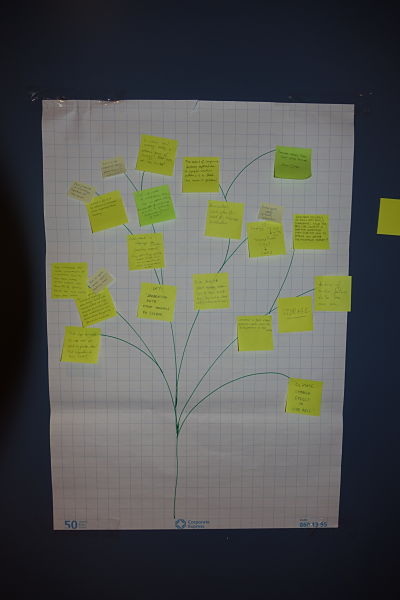
Debate and interaction
Without such an engaged audience, the day would not have been as great. In addition to scheduled elements, they participated actively with questions and feedback throughout the day.
Before lunch, an interactive element was added to the programme to stimulate discussion. Using an online questionnaire tool a number of propositions was presented and the participants could vote for one of the answers via their laptops or smartphones. This resulted in interesting discussions. Additionally, the audience was encouraged to contribute to a tangible outcome of the symposium by pasting post-its to what was introduced as an ‘idea-tree’. On these post-its they could write questions, propositions, interesting facts, etc. The original idea was that these post-its would be used to guide a discussion at the end of the day, but it turned out this wasn’t even necessary. Instead, the organizers requested that each participant write down a personal take-home message that they would like to share. Here, we have summarized some highlights of the discussion.
Storage capacity is the largest obstacle in the energy transition
The audience was divided on this preposition, with no clear answer. An important argument was that the gridsize will be much more important than storage: if the grid can’t handle the variable energy supply, then storage is not going to help one bit. On the other hand, dr. Vautard argued that we need a high storage capacity to compensate the change in demand from summer to winter: a more long-term storage perspective. An alternate problem for the energy transition was posed: what about political instability? A connected grid can be severly damaged if one of the participating countries is in political unrest.
Most progress in energy meteorology will come from increased computer power, not understanding
This was, in a room full of meteorologists, a sensitive preposition. A quarter of the votes went to the “I don’t want to agree” option, which is telling in itself! Proponents argued that with techniques as LES modelling we sometimes hit the limit of what is possible modelling wise, and simply need more power to proceed beyond there. Those opposed reasoned that parametrisation of processes requires understanding, before we can create models. The debate concluded with the notion that the observational limit is much stronger: we require more (accurate) observations before we need improved models.
Who needs to take the lead in the energy transition: Government, companies or citizens?
The room was divided about this preposition. About half decided on government, the other half mixed between citizens and companies. Main argument for the governments was that they have a responsibility, can create favourable circumstances for investments and design laws about renewables. However, as someone pointed out: shouldn’t it be the citizens that compel their government and large companies to make these changes? From the discussion it became evident that it’s very uncertain where the responsibility woud lie, which could explain the current status of the energy transition…
Geo-engineering will be indispensible (besides renewables) to combate climate change
The audience nearly unanimously decided that geo-engineering is as big a risk as climate change itself, given the large uncertainty. However, an interesting follow-up point was raised: isn’t making large wind or solar plants ALSO geo-engineering? By making modifications to the surface we change the energy balance (slightly), which is the definition of geo-engineering!